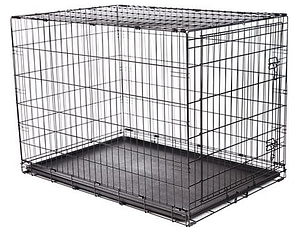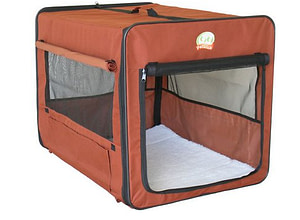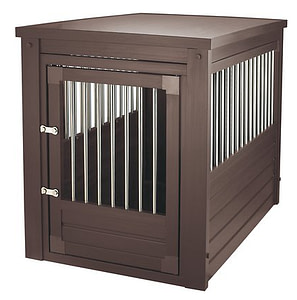When we think of crate training, we usually think of potty training our puppy. It makes sense because these two things go hand and hand. Using a crate is the best and most efficient way to potty train our dogs.
In this episode, I want to convince you that crate training goes way beyond potty training. If done correctly a crate can be an essential training tool and a way to give you peace of mind long after potty training is over.
In this episode of Your New Puppy I will go over:
- Benefits to crate training your dog (and keep them crate trained).
- Pros and cons of the main types of crates.
- Where in your house your crate should go.
- How to make your dog LOVE his crate.
- Tips if your dog doesn't love his crate right now.
Press play to listen to this podcast episode or subscribe to Your New Puppy where ever you listen to your podcasts.
Podcast: Play in new window | Download
Subscribe: Apple Podcasts | Spotify | Amazon Music
Resistance to Crate Training
I understand a lot of new dog owners can have resistance to using a crate altogether.
A lot of people see it as a cage or think it's unfair to the dog. Especially if you adopted them from a shelter. I hear this a lot that, “they were in a cage in the shelter. I don't want to have them in one at home…”
I want you to look at it from a different perspective. We have cribs and playpens for our children to give them a place where they can play or sleep. We have peace of mind knowing that they are safe while they're in there. A crate is for a dog is no different.
That’s why I'm going to give you some tips and pointers to make this a great oasis for your dog. That way your dog's going to love it and you're going to have peace of mind. It's a win-win situation.
Benefits to Crate Training Your Dog
The most common reasons for crate training is to help with potty training and keep them safe (and our stuff safe) while they are still in the chewing stage.
What happens is, once he's house trained and you trust him to be in the house unsupervised, then we come away from the crate and we stop using it altogether.
There are a lot of reasons to keep them used to and loving their crate way beyond puppy-hood.
When you have to board your dog. Especially if you go with a traditional boarding where they're going to be confined, even if it’s only at night, if your dog already has a good association with the crate with that, there's an extra peace of mind knowing that he's going to be comfortable there.
When I used to board dogs in my house I didn't require a crate (with the exception of puppies not yet potty trained) But if they were crate trained, I highly recommend bringing their crate because the dogs who slept in the crates at night made the best transition to the new environment. I very rarely had any kind of whining or anxiety.
If your dog ever has to stay at the vet, either overnight or just during the day, they're going to keep them in a kennel or crate. Knowing that they will be comfortable in the kennel can take away some of the stress that you will probably feel from having to leave them there in the first place.
The few times Lucy had to stay at the vet they commented to me on how comfortable my she was while staying there. She just curled up in the kennel and went sleep.
If you have people coming in and out of your house. They could be professionals working on your house or if you have a cleaning service that comes in a few times a month.
If you have visitors. Not everyone likes dogs (I don't understand it, but I respect it). Or everyone is dressed up. Maybe it's a child that's a little scared of dogs. It's great to have an option where you can give your dog a bully stick or a really great toy and he can chill in this crate for a little bit and be perfectly content.
If there is an emergency. It's something we don't always want to think about but if we ever need to evacuate our home if your dog can be kept in a crate, the options of where you can go and bring your dog with you, increase.
These are things that aren't going to happen every day, but when they do happen, it's really, nice to have that option.
Once your dog is an adult you don't have to keep them in their crate every day but just enough that they are used to it.
For my dogs, what I do is every single time I give my dogs a bully stick, they chew on it in their crate. Now as soon as my hand goes into the bully stick bin, they both run to their crates and that's where they chew on it. Lucy, my younger girl, still sleeps in her crate every night (I'll talk about her crate more in a minute).
Main Types of Crates
The first thing that you have to think about is which type of crate is going to work best for you. Let’s look at a few of the most common ones.
Wire (Life Stages) Crate:
The most popular one is the one that looks like a cage. It's the wire crate also known as the Life Stages Crate.
The biggest advantage to the wire crate is it has a divider where you can make the crate smaller when your dog is a puppy and then you move it out and the crate grows with your dog. Eventually, you can take it out and the dog has the whole crate.
The reason this is important is when it comes to potty training, the size of the crate matters. You want to come give him enough room where, he can stand up, turn around, and lie down, but no more. If you give them too much room they may go to the bathroom in one corner and then sleep in the other and you DO NOT want that. Once he learns he can go to the bathroom and the crate you use lose the crate as a tool then house training just becomes a whole lot harder.
(I go into potty training in detail in YNP #010: Complete Guide to Potty Training Your Puppy)
They'll also fold down easily for storage and travel. They can be a little heavy depending on the size.
With the wire crates, I also recommend putting blankets over them to kind of give them a snug feeling (I'll talk more about this in a moment).
- Most versatile.
- Divider to change the size of the crate to grow with the dog.
- Folds down for storage or transport.
- Looks the most like a cage.
- Needs towels or blankets on the outside to make cozy.
Plastic Kennel (Enclosed Crate)
The second most popular one is the plastic Kennel. What's nice about this one is that they're already kind of enclosed. So they already have that nice snug feeling.
The drawback is, is that they don't fold down nicely. So if you have a large crate for a large dog they can get big and bulky to store and travel with.
They also don't have a divider where the crate grows with the dog. So you might have to buy a small one when they are a puppy and get a bigger one later.
If you have a small dog, it's really easy to carry them around in these crates.
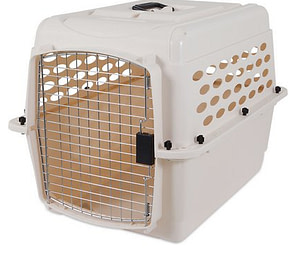
- Already enclosed and snug.
- Airport approved.
- No way to adjust the size for growing puppies.
- Can be bulky to travel with.
Soft (Travel) Crate
Another one that they have is called a travel crate or a soft-sided crate. It's incredibly light and it's already enclosed. A lot of them have zippers on the sides where you can open up a flat and vent it but still have a nice cozy feeling. They fold down super easy to take up very little space for storage or travel.
It doesn't have the life stages option where it will grow with the dog. The other downside is because it's only a canvas material, puppies and big chewers can chew through the material.
This is my favorite option if you plan to take your dog on adventures with you.
- Folds down and is light for easy travel.
- Already enclosed and snug.
- No way to adjust the size for growing puppies.
- Puppies and heavy chewers can chew holes in the material.
"End Table" Crate
The last type is these really nice crates that look like furniture. It's essentially this really nice piece of furniture that your dog can sleep in.
They are expensive and there are no travel options with them. It can be a good option if you are limited on space so your end table can also be your dog's crate. Or if you just want a nice looking crate.
- Attractive
- Can second as an end table.
- No travel or storage option.
- Expensive
To pick which one works best for you it all about how it's going to fit into your life, how it's going to work with your dog, and what you think the dogs gonna enjoy the most.
There are different options out there because everybody's situation is different.
Location in your house
Another decision to make is where in the house you should put the crate. This is another one I can't answer for you.
When they're a puppy and they're going to be in the crate more often because of potty training or you simply can't supervise.
During this time, it's nice to have them in a high traffic area, like a kitchen or a living room because then the dog will still be with the family even if he's hanging out in his crate napping or chewing on their bone during the day.
That being said, I also know that a lot of people like their dog to sleep in the bedroom with them. And your new puppy with adjust better at night. I have also seen a lot of puppies adjust just fine not being in the bedroom at night.
So...
Do you keep the crate in the bedroom? Do you keep the crate in the main family area? Do you have two crates? Do you move the crate?
It might be something you might have to play with to see where the dog's going to be the most comfortable and where it works best into your schedule, your family's lifestyle.
Create your Dog’s Oasis
Okay. So let's get down to how we're going to make this the best place for your dog to be. Your dog's little oasis.
Our goal is to give him a good association with his crate. We can do this in a few ways.
To start, never ever, ever, ever use the crate as punishment. It's really easy, when the dog's jumping around, really active, he's nipping and he kind of gets out of control, to get a little frustrated and put them in this crate. You want to avoid this. The crate is not a timeout tool. The crate is somewhere for him to rest and relax.
What IS a good idea is to get him nice and tired before putting him in the crate. Then he's just out and he's sleeping and it becomes the place where he gets to rest without being disturbed. You can also scoop him up and put him in his crate whenever he's taking a nap during the day.
You can have special treats that are only for the crate. Having that special treat for just in the crate gets makes the crate an extra special crate. I mentioned before that I use bully sticks. This can also be a deer antler or a favorite toy.
Feed him in his crate. You can put his food bowl right in the crate with him. I recommend using a Kong. You can stuff a Kong with their food, maybe a little bit of peanut butter or some other healthy treat like yogurt and mix it in there. It's great because he's occupied in his crate, he's happy because he's eating this fun, treat and he's also taking more time and more energy just to eat his meal
I talk about using a Kong for mealtime in more detail in Episode 18: Ditch the Bowl and Make Mealtime an Event
Make it cozy! When I talked about the different crates above I mentioned making the crate snug and cozy. This is the most important step. You want to create a little cave. This is a picture of Lucy's crate. I have to pull other dogs out of her crate all the time because everyone wants to sleep in it. I have all sides covered with a blanket to make a little cave. Then inside is a fleece bed and soft blankets to curl up in.
Note: Young puppies will probably chew on the bedding. Using an old towel or possibly no bedding at all may be necessary at first.
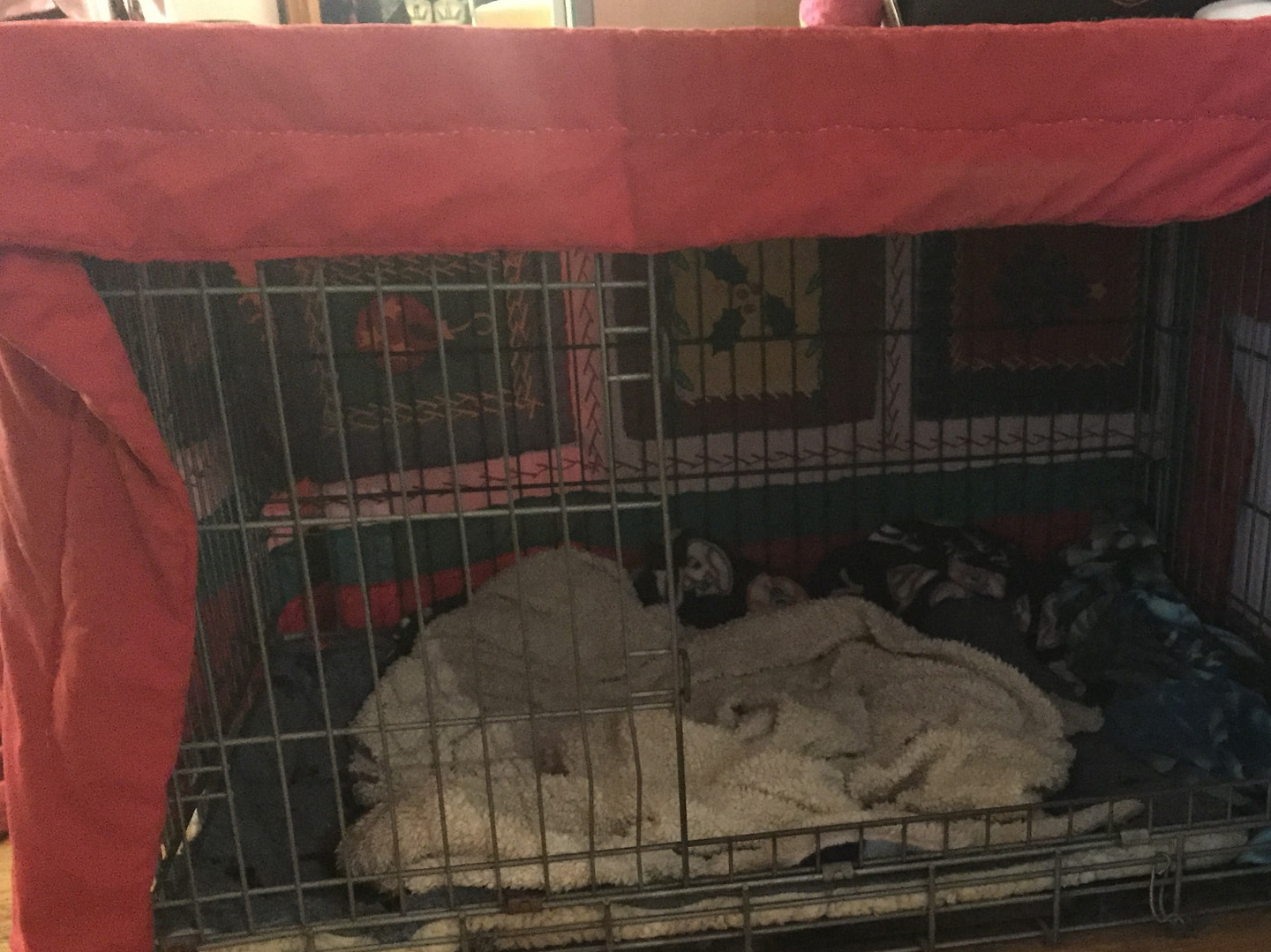
Each of these things you can do at first just to get them to love his crate. You don't have to do it forever (or you can!). You can anything that's gonna be enjoyable, safe and he's in his crate.
Pro tip: If you give them a squeaky toy, take it out before you go to bed. Especially if he's going to be in your bedroom because sometimes they don't know that at 2:00 am it's not the time to play it with that squeaky toy.
Introducing your puppy (or dog)
If you just have a puppy or if you're bringing a new dog home this is relatively easy.
Follow these steps to introduce or reintroduce your dog to their crate. Only move onto the next step when your dog is comfortable with the current step.
- Set up the crate and leave the door open. Don't ask them to go in, just let them get used to the crate's presence. An option is to feed him near the crate.
- Play with your dog and throw toys and treats into the crate. Continue to leave the door open. Let your dog run in and get the toy and treat and come right back out.
- Continue to throw his toy or treats in the crate. When he goes in close the door and immediately open it.
- Continue to throw his toy or treats in the crate. Close the door for longer and longer periods of time (1 second, 5 seconds, 10 seconds, etc.).
If you're dog already doesn't like the crate
First we want to see why your dog is uncomfortable and it could have nothing to do with the crate. These are the most common reasons that a puppy or dog doesn't like their crate.
Something "bad" is happening when they go in their crate. If you only use the crate when you leave the house then your dog is associating his crate with you leaving. Or if you put them in the crate and then use the vacuum. Be aware of what is happening while your dog is in their crate. Remember we want make sure it's a positive experience.
They don't hate their crate, they are getting some kind of attention for whining. Most of the time when a dog, especially a puppy is continually whining in the crate it isn't that they hate the crate, they are trying to get your attention. Walking back into the room, a quick "it's OK", or worst of all, letting them out will encourage them to do it again. You need to completely ignore them whine you are initially crating training a puppy.
I talk more about why puppies will whine in the crate in Episode 28: 5 Reasons to Use the Crate When You're Home.
Big picture
Crate training your dog has lots of benefits. When done correctly it will become a multi functional training tool.
Pick the crate and location that works best for your family. Then create a good association by making it cozy, making all good things happen in the crate, and never use it as punishment.
Press play to listen to the full podcast episode.
Podcast: Play in new window | Download
Subscribe: Apple Podcasts | Spotify | Amazon Music

